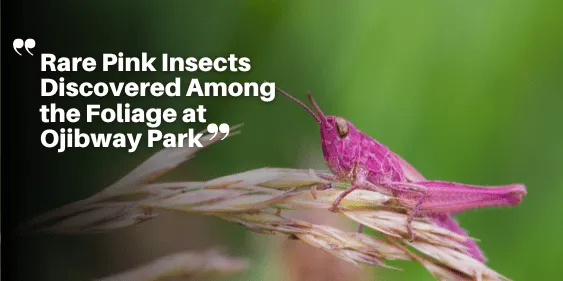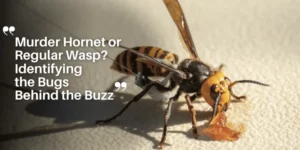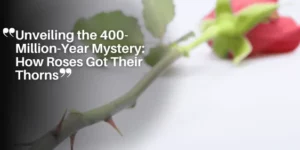Rare Pink Insects Discovered Among the Foliage at Ojibway Park

In the vibrant city of Windsor, an extraordinary discovery has captivated both local nature enthusiasts and scientific communities.
The rare and striking pink katydids have been spotted thriving in the lush foliage of Ojibway Park, a phenomenon that has sparked widespread interest and admiration.
This remarkable find not only highlights the park’s ecological significance but also underscores the dedication of those who have uncovered this unique species.
The Journey of a Windsorite into the World of Rare Insects
The story of these elusive pink katydids begins with a Windsorite named Pekor, whose keen eye and passion for entomology led him to this fascinating discovery.
Pekor’s fascination with these rare insects was ignited when he was shown a photograph of a pink katydid by a fellow nature and insect enthusiast.
This initial exposure sparked a deep-seated interest, prompting Pekor to embark on a quest to capture images of these rare insects.
Armed with a flashlight and a keen observational skill, Pekor began his nocturnal expeditions through Ojibway Park, meticulously scanning the trails for these elusive creatures.
“I was out one night, and as I directed my flashlight along the foliage, I came across a stunning pink katydid,” Pekor recalled.
This chance encounter marked the beginning of a dedicated effort to document these extraordinary insects.
Pekor’s meticulous work resulted in a captivating collection of photographs showcasing the pink katydid’s unique beauty in exquisite detail.
From Local Discovery to Scientific Recognition
Pekor’s impressive photographic documentation did not go unnoticed.
His striking images of the pink katydids attracted the attention of the Montreal Insectarium.
Representatives from the Insectarium visited Ojibway Park with the necessary permits to collect a few specimens for their exhibit.
This recognition underscores the broader scientific interest in these rare insects and highlights the significance of Pekor’s discovery.
In addition to his contributions to the Insectarium’s collection, Pekor has been actively involved in volunteer work with various universities in Ontario.
His efforts include cataloging diverse insect species, including spiders and, notably, the elusive pink katydids.
Pekor’s commitment to this cause exemplifies his dedication to advancing our understanding of these rare insects.
Unraveling the Mystery Behind Pink Katydids
The vibrant pink coloration of these katydids is attributed to a recessive gene, according to David Lowenstein, an entomologist from Michigan State University.
This genetic trait is comparable to albinism observed in other animals.
Such genetic variations are relatively rare, occurring in approximately one in every 500 katydids.
The pink coloration remains throughout the insect’s life, from the immature stages to adulthood.
However, if a pink katydid mates with a green katydid, the offspring will likely be green, as the recessive pink gene is less common.
Handling Pink Katydids: What You Need to Know
For those fortunate enough to encounter a pink katydid, there is reassuring news: these insects are not harmful to handle.
“Seeing a pink katydid is not cause for concern,” Lowenstein assured.
“If you spot one, you can approach it safely.
Adult katydids might fly away if disturbed, but there is no need to worry about any adverse effects from encountering these insects.”
This reassurance adds to the allure of the pink katydid, which represents one of the many “unusual quirks” in the insect world.
These quirks may relate to the insect’s appearance or its ecological role.
The rarity of pink katydids can be attributed to their visibility to predators.
Typically, katydids rely on camouflage to avoid being eaten, and the striking pink coloration disrupts this natural defense mechanism.
Ojibway Park: A Sanctuary for Rare and Unusual Species
Ojibway Park is not just a haven for the rare pink katydids but also a rich ecological environment that supports a diverse array of species.
The park’s variety of flora and fauna creates an ideal setting for numerous uncommon organisms to thrive.
Pekor’s observations suggest that Ojibway Park serves as a crucial habitat for many intriguing and rare species.
“It’s a place where the unexpected is always around the corner,” Pekor noted.
“The variety of species here is remarkable, and you never know what you might discover.”
This sentiment reflects the park’s value as a natural resource and a site of ongoing scientific interest.
Future Research and Exploration
The discovery of pink katydids in Ojibway Park opens new avenues for research and exploration.
Continued study of these rare insects could provide valuable insights into insect population dynamics and their adaptations.
The mission GOLD, a NASA initiative, offers a relevant parallel in terms of observing and documenting rare phenomena.
Just as the GOLD mission revealed new atmospheric structures, studying pink katydids could deepen our understanding of these unique insects.






